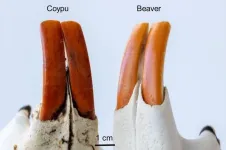One million US dollars for mapping the “springs of the spinal fluid”
Bonn researchers aim to measure intricate brain structures with artificial intelligence
2024-04-17
(Press-News.org)
A research team at DZNE has been awarded around one million US dollars for the development of an innovative, AI-based method to measure the “choroid plexus” three-dimensionally in human brain scans. These finely branched brain structures are the main sources of the “cerebrospinal fluid” and thus of great significance for the function of the brain and spinal cord. It is also assumed that they play a role in various neurological diseases, including Alzheimer’s. The research project is funded by the US National Institutes of Health (NIH).
The “cerebrospinal fluid” (CSF) is a watery liquid that circulates in the brain and spinal cord. It carries nutrients and metabolic products, dampens shocks and largely originates from cavities deep inside the brain. The actual “springs” are complexly shaped appendages of the brain tissue that protrude into these cavities and the cerebrospinal fluid they contain. “Choroid plexus” is the technical term for the elongated, highly branched structures that produce the CSF. Every individual has four of them, some of which are interconnected. At the same time, these structures are relatively small; in adults they have a total volume similar to that of a sugar cube. “Such delicate brain structures are difficult to capture in living humans. That’s why we want to develop an AI-supported method that automatically identifies the choroid plexuses in brain scans so that their shape and dimensions can be precisely determined,” explains Prof. Martin Reuter, an expert in AI in image analysis and research group leader at DZNE. “Automated and precise measurements of these structures will help to better understand disease processes and normal brain changes over the course of life.”
Digital “dissection” of the brain
For this undertaking, the Bonn scientist and his team will draw on three-dimensional brain magnetic resonance images (MRI). This wil involve data from the NIH’s “Human Connectome Project” and from other sources. In total, data from around 700 participants will be included. Although computer algorithms exist in principle for the intended separation of the brain images into different areas – experts call this “segmentation” – they are too inaccurate for the choroid plexuses. “For these complicated brain structures, you need a specialized, fully automatic tool. We don’t have that in good quality yet. And segmentation by hand, where one marks the contours of the relevant tissue on the screen with a mouse click, is laborious and prone to errors,” says Reuter. “That’s why we aim to develop a method that can be used to efficiently and reliably evaluate large brain MRI data sets. Just as is required for studies with a large number of participants. These could be drug trials or studies on ageing, for example, such as the Rhineland Study of the DZNE here in Bonn.”
Five-year runtime
In this project, DZNE will cooperate closely with US institutions, in particular with the “Beth Israel Deaconess Medical Center” in Boston, a Harvard Medical School affiliate. At the end, a software based on advanced artificial intelligence shall be available that has “learned” through examples – so-called training data – to recognize the “springs of CSF” in MRI data. The development of the necessary algorithms, and their training and validation, are labor-intensive efforts. Already the selection and creation of suitable training data in advance is time-consuming. Therefore, the research project is scheduled for five years. Reuter is hoping for a digital instrument that will be widely used in research: “We are going to design our tool so that it works with data of different resolutions and from different types of brain scanners. We also plan to make the software freely available within the open source FastSurfer project for brain MRI analysis, developed at DZNE.”
--
About the Deutsches Zentrum für Neurodegenerative Erkrankungen, DZNE (German Center for Neurodegenerative Diseases): DZNE is a research institute for neurodegenerative diseases such as Alzheimer’s, Parkinson’s and ALS, which are associated with dementia, movement disorders and other serious health impairments. To date, there are no cures for these diseases, which represent an enormous burden for countless affected individuals, their families, and the healthcare system. The aim of DZNE is to develop novel strategies for prevention, diagnosis, care, as well as treatment, and to transfer them into practice. DZNE comprises ten sites across Germany, it cooperates with universities, university hospitals, research centers and other institutions in Germany and abroad. It is a member of the Helmholtz Association and of the German Centers for Health Research. www.dzne.de/en
END
ELSE PRESS RELEASES FROM THIS DATE:
2024-04-17
This report presents gained knowledge identified at two events during the Greenland Science Week on the 7th of November 2023 in Nuuk, Greenland:
The 1st Biennial Greenland Marine Research Seminar and
The workshop on Status and Development for East Greenland Waters
Both events had a forward-looking focus, to gain insight and knowledge from stakeholders and other parties, to be implemented in future research. The marine research seminar also served as a follow-up on earlier ECOTIP and Face-It stakeholder involvement in Greenland and was an opportunity to share project results and recommendations ...
2024-04-17
Highlights:
In lab experiments, copper shows antimicrobial properties, including against pathogens like Salmonella.
Copper beads in animal feeds may improve gut health in pigs.
A new bead design effectively delivers copper to the lower intestine.
New findings show copper beads influence the microbial makeup in a pig’s gut, but more work is needed to optimize the benefits.
Washington, D.C. — April 17, 2024 — Copper is a natural antimicrobial material that, when added to pig feed, may promote the growth and ...
2024-04-17
Florida Atlantic University’s College of Engineering and Computer Science is among eight university teams in the United States selected to work with NASA and the U.S. military to foster innovation and expertise in the small satellite sector.
NASA’s CubeSat Launch Initiative (CSLI) is partnering with the U.S. Air Force and U.S. Space Force for the 2024 Mission Concept Program. A CubeSat is among a class of research spacecraft called nanosatellites about the size of a 4-inch cube and typically weighing less than 5 pounds.
Running from May through August, the University Nanosatellite ...
2024-04-17
Waltham — April 10, 2024 — The nursing work environment, nurse education, and staffing levels are independent factors affecting hospital scores on a key measure of patient-centered care – with significant implications for reimbursements, reports a study in Medical Care. The journal is published in the Lippincott portfolio by Wolters Kluwer.
"Our results provide evidence-based guidance about which modifiable aspects of hospital nursing are likely to improve patient experience ratings," said Kathleen E. Fitzpatrick Rosenbaum, PhD, RN, CCRN, of Yale University.
How do nursing factors affect HCAHPS ...
2024-04-17
Researchers at Weill Cornell Medicine have developed a powerful, new technique to generate “movies” of changing protein structures and speeds of up to 50 frames per second.
Senior author, Dr. Simon Scheuring, the Distinguished Professor of Anesthesiology Research at Weill Cornell Medicine and colleagues developed the new approach to gain a better understanding of how biological molecules change structurally over time. Although investigators in this field routinely image static proteins and other molecules finely ...
2024-04-17
Chattering squirrels, charming coypus, and tail-slapping beavers — along with some other rodents — have orange-brown front teeth. Researchers have published high-resolution images of rodent incisors in ACS Nano, providing an atomic-level view of the teeth’s ingenious enamel and its coating. They discovered tiny pockets of iron-rich materials in the enamel that form a protective shield for the teeth but, importantly, don’t contribute to the orange-brown hue — new insights that could improve human dentistry.
Human and animal teeth are coated in a ...
2024-04-17
DALLAS, April 17, 2024 — Language barriers, longstanding structural racism barriers, underrepresentation within the ranks of health care professionals and higher than average rates of poor health risk factors are among the alarming trends that continue to impede quality health care outcomes for Hispanic Latino people living in the United States. The American Heart Association, celebrating 100 years of lifesaving service as the world’s leading nonprofit organization focused on heart and brain health for all, is making strides ...
2024-04-17
Glenview, Illinois – Esha Kapania, MD, will be the mentee for the inaugural year of the 2024 APCCMPD and CHEST Medical Educator Scholar Diversity Fellowship.
Designed to pair a fellow-in-training with an established medical educator, the unique scholarship was launched in August by the American College of Chest Physicians (CHEST) and the Association of Pulmonary and Critical Care Medicine Program Directors (APCCMPD) to improve diversity in pulmonary and critical care medical education.
The program focuses ...
2024-04-17
PULLMAN, Wash. – While the electronic tongue bears little physical resemblance to its namesake, the strand-like sensory probes of the “e-tongue” still outperformed human senses when detecting contaminated wine in a recent study.
In an experiment at Washington State University, the e-tongue identified signs of microorganisms in white wine within a week after contamination—four weeks before a human panel noticed the change in aroma. This was also before those microbes could be grown from the wine in a petri-dish. Winemakers traditionally rely on these two methods, sniffing the wine and petri-dish testing, to ...
2024-04-17
Research Highlights:
Almost 1 in 5 adults with congenital heart disease living in Israel had or developed an abnormal heart rhythm over five years.
Adults with congenital heart disease who developed an irregular heart rhythm in the heart’s upper chambers faced a 65% increased risk of premature death.
The adults who developed an irregular heart rhythm in the heart’s lower chambers had double the risk of premature death.
Embargoed until 4 a.m. CT/5 a.m. ET Wednesday, April 17, 2024
DALLAS, April 17, 2024 — Almost 1 in 5 adults with congenital heart disease living in Israel had or developed an abnormal ...
LAST 30 PRESS RELEASES:
[Press-News.org] One million US dollars for mapping the “springs of the spinal fluid”
Bonn researchers aim to measure intricate brain structures with artificial intelligence


